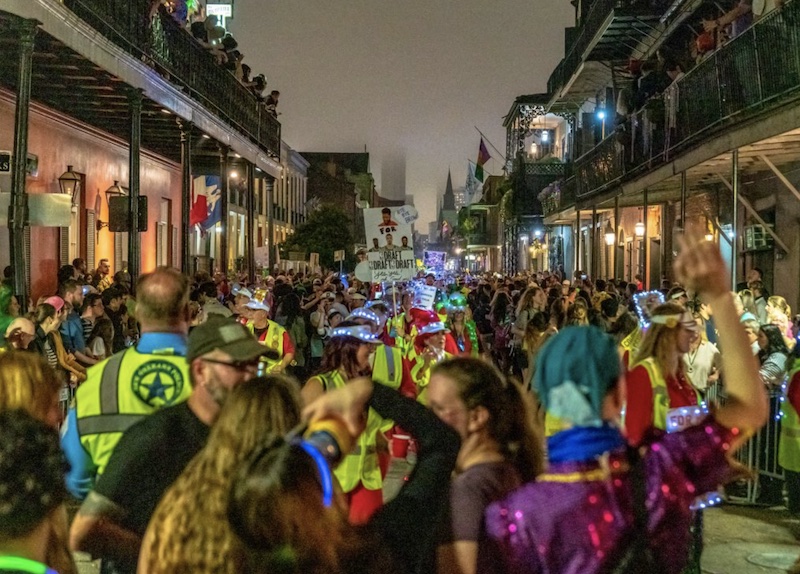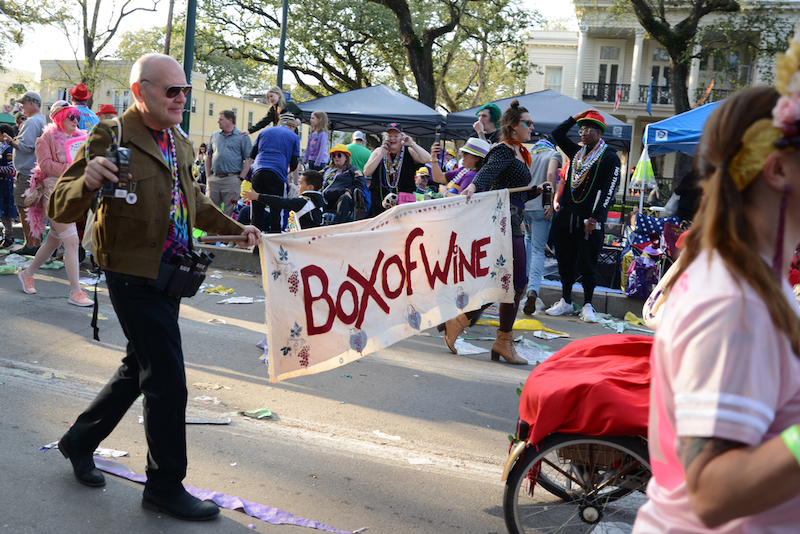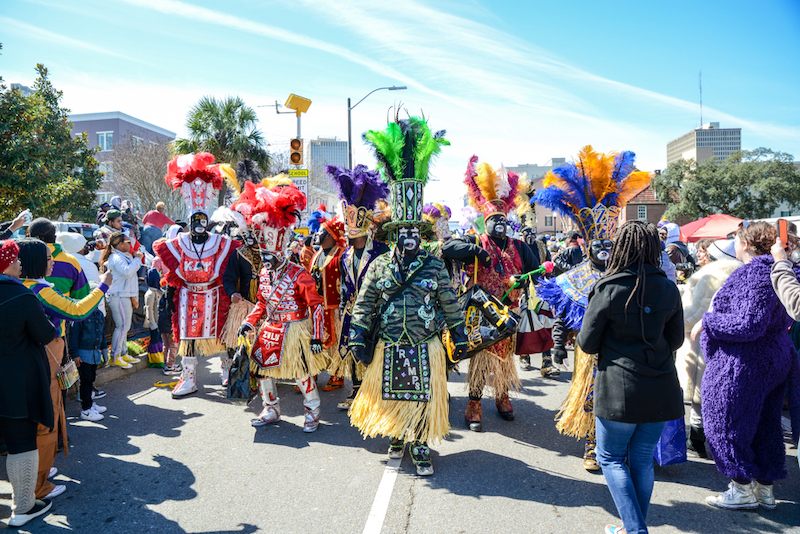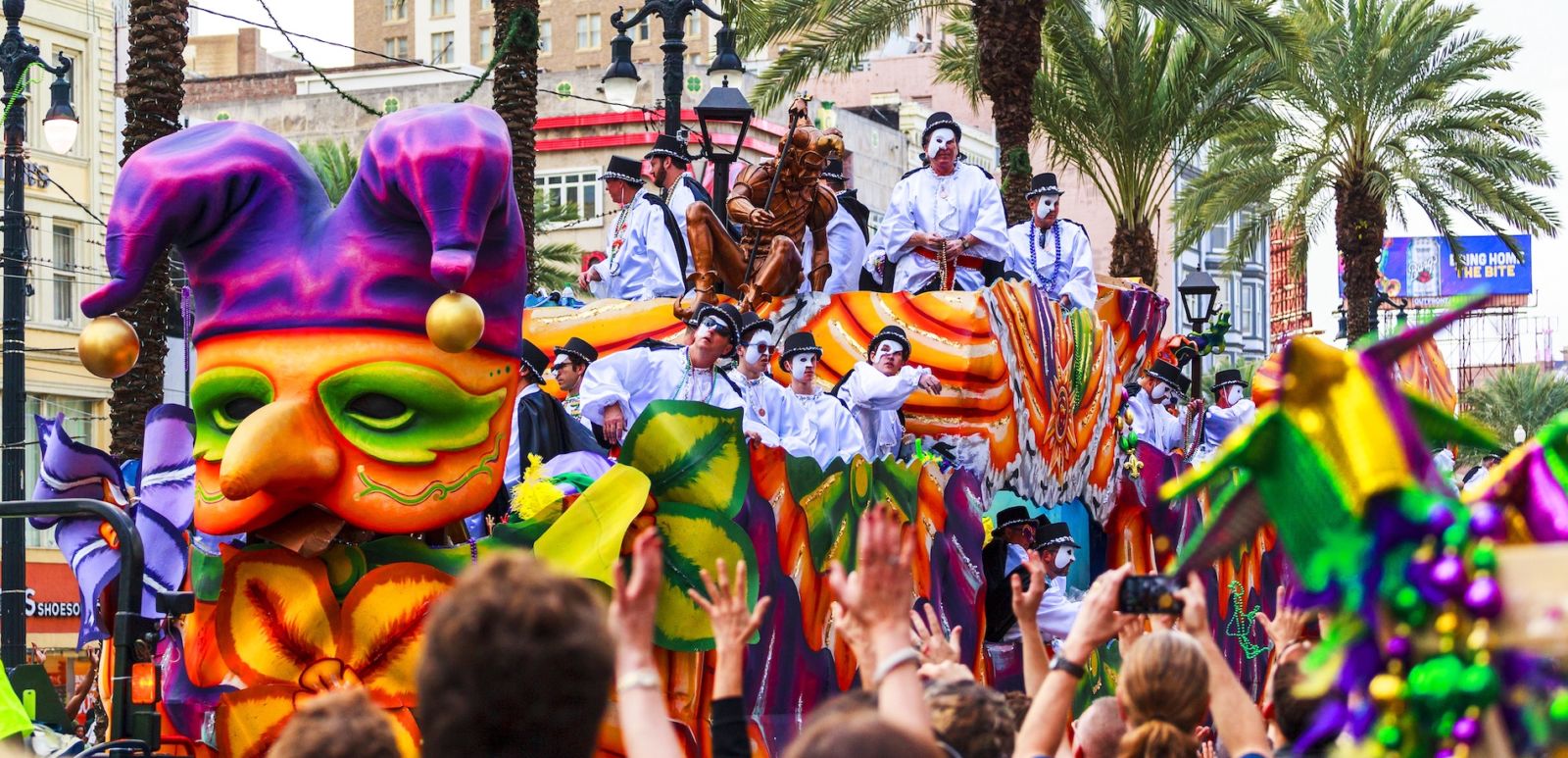Amid its whimsy and indulgence, there is a curious contradiction afoot during Mardi Gras season in New Orleans: however much the holiday may be about gathering in the streets to extol community and kinship, it’s also deviously defiant.
It’s common knowledge that Mardi Gras is, historically, a Catholic tradition, one geared to provide adherents with one last hurrah on the eve of their 40 days of Lenten repentance. If we go back far enough, however, we find even more in insubordinate origins. Ancient traditions like the Roman Saturnalia — which celebrated a radical, if temporary, inversion of social order, effectively allowing the poor to rule the rich for a day — gradually evolved and spawned similar expressions throughout history. In the northern Italian town of Ivrea, for example, commoners hurl oranges at costumed carriage riders in celebration of the tale of the miller’s daughter, where a bride-to-be, unwilling to be the next victim of the ius primae noctis, decapitated the king, burned the castle and ran his court out of town.
Apart from its procession of carriages and hurling of objects — the latter of which might be, in the case of the miller’s daughter, viewed as an attempt to placate the commoners — the bloated, bead-boob brand of Carnival many experience when visiting New Orleans seems to have little overtly in common with its political, anti-establishment forebears. Thankfully, those who venture beyond the balconies of Bourbon Street will find that New Orleans’ Mardi Gras actually extends far beyond one parade, one spirit or even one day. Here are just a few rebellious krewes to keep an eye — or, perhaps, a more southerly body part — out for.
Krewe du Vieux + krewedelusion (Saturday, February 4)

Though Mardi Gras season officially kicks off on the Epiphany Eve — or Twelfth Night, landing as it does, on the last night of Christmas — Carnival doesn’t feel like it’s truly started until Krewe du Vieux rolls. Since 1987, the krewe’s principal aim is to shock and dissent through its 17 sub-krewes, from the Krewe of Underwear to the Krewe du Mishigas, each united by annual themes of political satire. In 2022, that theme was “Vaxxed and Confused.” In 2016 it was “Krewe du Vieuxxx,” celebrating the krewe’s 30th anniversary with the most tawdry of Roman numerals. But novelty always threatens to shortcut cool, and in 2010, an even smuttier newcomer, krewedelusion, came on the scene, crowning its first king — noted Simpson Harry Shearer — with a promise to raise the bar ever wryer.
Given that the latter parade marches immediately following the former, one should expect a healthy dose of barbed puns and papier-mâché phalluses throughout the night. As the two parades seek to outdo one another, the march toward subversion drives onward.
Bacchus + Box of Wine (Sunday, February 19)

Ambling into the streets without an official start time or parade route, Box of Wine exists to unofficially announce the arrival of Bacchus, luring the more innocent among us directly into the clutches of the mightiest megaparade on that final Sunday before Mardi Gras.
Like the beastly Krewe that it precedes, Box of Wine pays existential and quasi-phonetic homage to the Roman God of wine and fertility. Unlike Bacchus, however, Box of Wine doesn’t bother with unsustainable plastic throws or bunglesome floats, instead pouring boxes of wine down the gullets of the willing, particularly those who arrive on the sidelines dressed in white and ready to be stained by that blood-red gush.
Though it’s quite impossible to miss Bacchus, thanks to its 32 über-floats and their accompanying marching bands, Box of Wine is more elusive. You might require the benefit of an insider tip to head off the mini-krewe at its point of departure, or suffer a stroke of good fortune in tracking their understandably snaggled path toward oblivion. If not, you’ll be stuck settling for perhaps the mightiest parade you’ll ever witness. Poor you!
Red Beans vs. Dead Beans (Monday, February 20)
In the weekend’s aftermath and in anticipation of an early and ecstatic Tuesday, Lundi Gras (Fat Monday) can be a welcome off day for some. Others might find themselves committed to the pair of traditional Uptown Super Krewes in Proteus and Orpheus. As a nice halfway point, the Krewe of Red Beans offers an opportunity to rub elbows with legume-festooned freaks within the hepcat-friendly confines of the Marigny.
The Krewe of Red Beans pays homage to the intricate beadwork of the Mardi Gras Indians and to that seminal New Orleans staple, red beans and rice, traditionally enjoyed on Mondays. Here, the floats are the costumes themselves: as brass bands make their way down Esplanade Avenue, participants in this petarade parade sport custom-made attire rife with puns. Some might sport a legume-encrusted kite in a bit of “Beanjamin” Franklin cosplay, while others might drape themselves in “L.L. Bean” drab, or simply wrap their heads in a “turbean” made of lentils.
If Red Beans’ scatological foibles aren’t odd enough for you, you might consider its posthumous partner, Dead Beans. First founded in 2018 to honor New Orleans’ unique embrace of the afterlife, this skeleton krewe allows participants to parade independently in neighboring Bayou St. John before facing off against them in front of the Backstreet Cultural Museum in the Tremé, brass bands and all, for one massive, protein-packed dance party.
Zulu vs. Mardi Gras Indians (Tuesday, February 21)

Options obviously abound when it comes to the big day, from the rich traditions of Zulu, arguably the most important of the Super Krewes, to the Northside Skull + Bones Gang in the Sixth Ward, to the French Quarter antics of St. Anne. While it’s impossible and ill-conceived to do it all, a certain tradition dictates that it is advisable to rise at the crack of dawn with an Irish coffee and your radio dial tuned to WWOZ 90.7 FM.
If you’re lucky, the world’s greatest radio station might clue you in to the coordinates of Wild Tchoupitoulas, the sovereign Washitaw Nation or one of dozens of other Mardi Gras Indian tribes set to air it out with the unspeakably beautiful costumes they’ve spent all year hand-sewing. Founded in honor of the Native Americans who once sheltered the enslaved African Americans fleeing their captors, these tribes withstood many years of bloody conflict among themselves and now focus their energies on colorful pageantry, song and dance. As far as spectacles are concerned, there simply isn’t anything else like it.
Once you’ve seen Spy Boy clear the way for his compatriots, you’ll have an entire day’s worth of paths to take. You might follow the booming voice of Big Chief for a while, or wander off to whatever trouble you can stir up within reasonable bounds of the law.
Endymion vs. PBLESPBG (Saturday, February 18)

Lastly, let’s not forget the Technicolor behemoth that engulfs the city on the final Saturday before Mardi Gras. It’s a rag-tag tradition fresh on the scene and dead-set on undermining the Super krewe of Endymion through the most unlikely of means: bedraggled, beer-league baseball.
Since its founding in 1967, Endymion has dominated the Mid-City neighborhood, and is now 3,200 revelers atop 81 floats and as many as 15 million carnival-colored doodads thrown to thirsty onlookers. It culminates in the biggest of balls at the Superdome and has historically attracted a rather strange brand of star power. In 2022, cut-rate conservative pundit Raymond Arroyo led the parade down Canal Street as its Grand Marshall. This year’s honor was briefly bestowed upon, then retracted from “The Expendables” — and seemingly expendable — star, Mel Gibson, of all people.
And while Endymion may be a thrill for most, there are some residents in Mid-City — among whom this author has been counted — who aren’t so pleased by its presence. As Endymion rolls, a small contingent of demi-athletes has, under the banner of the People’s Baseball League, united in direct protest of this lumbering beast of a parade.
Now in its fifth year, the People’s Baseball League Endymion Saturday Protest Baseball Game, or PBLESPBG for short, showcases some of that upstart league’s most slovenly stars — among whom, it must be noted once again, this writer has been occasionally and regretfully counted — as they play soggy hardball in full costume and in full view of the confused civilians who make their way to the big parade, culminating in a modest crawfish boil for those still standing. Miniscule though it may be, spectators of all stripes are welcome to drop by to witness a few at bats and participate in yet another installment in the time-tested Mardi Gras tradition of collectively thumbing one’s nose at The Man, whomever that man may be.
Of course, this list only begins to describe the many avenues one might take in Orleans Parish and beyond: from Franklin to Mobile, from Aix to Zwolle, there are seemingly infinite ways one might bid pleasure adieu. However you choose to spend your Carnival, the most important thing is to join up, to give in to wherever the day, week or month takes you and, above all, to defy.




